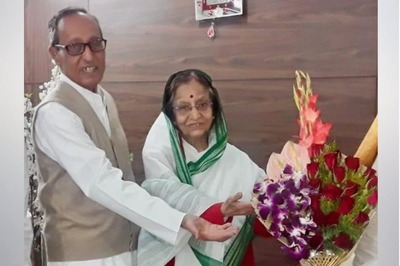
views
For the past decade, seven lives, mostly children, were lost in Gorakhpur every day due to acute encephalitis syndrome (AES) and Japanese encephalitis (JE). Three successive governments were elected and each had a near identical response to the disease.
Before he had become the chief minister in 2017, Yogi Adityanath was the first to raise the issue of these deaths nationally. His victory was soon followed with 71 children dying in 10 days at Baba Raghav Das (BRD) Medical College in Gorakhpur.
The disease's eradication, the former Gorakhpur MP promised, was his priority. And his formula: to strengthen primary health care, increase the scope of immunization for JE, improve quality of water, improve sanitation and increase awareness.
A decade ago, on March 19, this was the same formula that 32 doctors from the hospital were prescribed by the National Vector Borne Diseases Control Program (NVBDCP) in a day-long workshop. A doctor, who participated in the program and later left the hospital, said, "It's the same formula that keeps getting repeated because it is the best solution we have. The problem lies in the fact that no one is remotely interested in executing it."
A total of 25,000 deaths are estimated to have taken place due to AES and JE since 1978. In the past decade, there have been over 8,000 deaths — an average of seven every day, as per state records. But government action has inevitably been in response to specific outrage.
So in 2005, after over 1,000 deaths were recorded, Rajesh Mani, who is the petitioner on the issue in Allahabad high court for non-profit Manav Seva Sansthan, said, “That was the first time there was a discussion on the issue."
Situation 'Pathetic', NCPCR to BSP Government
Responding to the PIL in the Allahabad high court, the Mayawati-led BSP government took recourse to the same formula: "All primary health care centres (PHC) and community health care centres (CHC) had necessary medicines for treatment of encephalitis and the awareness program was yielding result."
The situation on the ground, as per the National Commission for Protection of Child Rights (NCPCR), in 2011 was "pathetic". It wrote that the “inaction of the administration is well reflected by the fact that the proposal to curb the diseases were sent only the same year in spite of the disease "persisting for the last 33 years".
Member secretary Lov Verma wrote that the team that visited Gorakhpur was "highly dissatisfied over the unpreparedness of the Health Department to stop the deaths of the children" and that it found that "the situation in those villages was pathetic; children were drinking unsafe water, there was no awareness on sanitation and cleanliness issues". A retired IAS officer explained, "The elections were around the corner. The NRHM scam was in the headlines. It was clear that the plan was there, but who would take ownership?"
'Deaths Soared. Our Hands Tied': Officials in SP Government
In 2014, when the UP government was asked to a submit a report on the continuing deaths, the Samajwadi Party-ruled government took recourse to the same formula. Efforts including vaccination, provision of 'safe drinking water', improved sanitation, construction of 'water sealed toilets' and health awareness activities had resulted in a decrease in mortality, said principal secretary (health) of the UP government. Mortality had decrease from 28.54% in 2005 to 18.78% in the year 2014.
But in 2016, as the then chief minister Akhilesh Yadav spoke of 'transformed health care' in the state, the claims were punctured by 104 AES and JE deaths in Gorakhpur — a 16 percent increase from the previous year. The government came under further criticism as it came to light that Rs 3 crore, which was released on BRD Medical College's request, was soon "taken back".
"At the time AES and JE were not listed as incurable diseases. As a result, the government said it couldn't release the money. So deaths soared. Our hands were tied. What could we do with broken down machinery and not enough money to pay our staff," admitted an official at the BRD hospital.
BJP Govt Claims Situation Has Improved. But Has It?
The first year of the BJP government saw a spike in the number of cases of AES and JE deaths — from 715 in 2016 to 748. But for CM Adityanath, the issue was always going to be key and the deaths in August had only made it all the more important. The formula, the CM announced in January 2018, followed the contours of the same formula. The government is yet to submit its report on the issue to the NHRC, sources added.
So far, the government has claimed that its vaccination drive has seen a "100% coverage, toilets have been built, sanitation has improved and deaths have decreased". But with the government reticent to share data regarding the actual number of cases and deaths, Mani argues, "It is impossible to actually verify these claims. Perhaps, there has been a marginal improvement. But there is still a long way to go."
(This story is the first of five-part series probing the encephalitis menace that hits Gorakhpur every year)


















Comments
0 comment